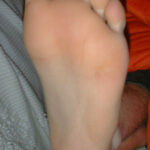Twitching muscles can have some people fearing they have ALS, that incurable fatal disease that causes muscles to waste away. A classic symptom of ALS is muscle weakness. People with twitching muscles who think they have ALS are prone to relentlessly performing muscle strength tests. People with muscle twitching are often never satisfied, however, if they “pass” one of their invented strength tests.
Though twitching muscles is a very common phenomenon, a certain percentage of people invariably google those key words, twitching muscles, which then brings them to ALS links. Muscle twitching is a symptom of ALS. The person may then start panicking he or she has ALS. However, ALS muscle twitching comes after muscle weakness, not before. So the person then starts imagining he or she has muscle weakness.
This phenomenon is called “perceived muscle weakness.” In ALS, the muscle weakness is called “clinical muscle weakness.” The panic does not subside and the person embarks on a daily mission of muscle strength testing. This strength testing can become obsessive, and unknown to those closest to the person. I have to believe that one reason the panic never subsides in some individuals is because their strength tests aren’t very efficient.
So I have come up with strength tests that, if you pass, there’s no way you can have the clinical weakness of ALS.
Muscle strength tests for fingers:
Piano and guitar playing, if you already play these instruments. There is absolutely NO way Jose that a neurologically damaged finger from ALS can manipulate guitar strings or piano keys as well as you’ve always played them. So if you can get through your most difficult songs without a hitch, you can rule out ALS. Though this requires no strength per se, it still requires a degree of neurological skills that would be absent in ALS.
For the thumb and/or index finger strength:
Find a bottle of white-out (correction fluid) or nail polish. The diameter of the cap is perfect for this strength test. Using just your suspected thumb and index finger, screw the cap on as tightly as possible. If you have ALS, you’ll immediately feel unable to do this. Now, with just the thumb and index finger, unscrew this tight cap. If you’re having trouble unscrewing it, don’t panic, because this means you were strong enough to screw it on so tightly in the first place! Furthermore, if you had ALS, you’d immediately detect a handicap in any attempts to unscrew the tight cap. With a few attempts, you’ll be able to unscrew it; and you’ll detect strength in doing so.
Additional strength tests:
Screwing on lids of mayonnaise or peanut butter jars is a great strength test; screw them on as tight as possible. An ALS weakness will prevent you from doing so. Now, unscrew them. Again, if you have difficulty unscrewing them, this does NOT mean muscle weakness; it means muscle strength that was applied to tightly screwing on the lid!
Find a very thick encyclopedia or two moderately thick books. Place book(s) end-up on the floor. Pick them up with thumb on one side and fingers on the other, without palm touching. Clinical weakness will prevent you from doing so, or, if you’re able to despite actual ALS clinical weakness, you will immediately feel an uncharacteristic gripping deficit.
Buy hand grip strength devices. Compare hands. If you have clinical weakness, the affected hand/fingers will be dramatically weaker, not slightly weaker.




